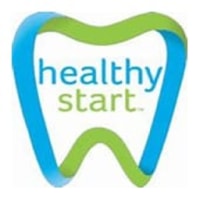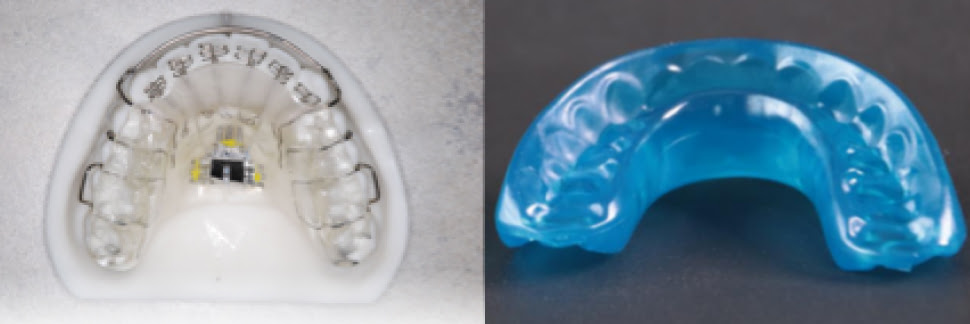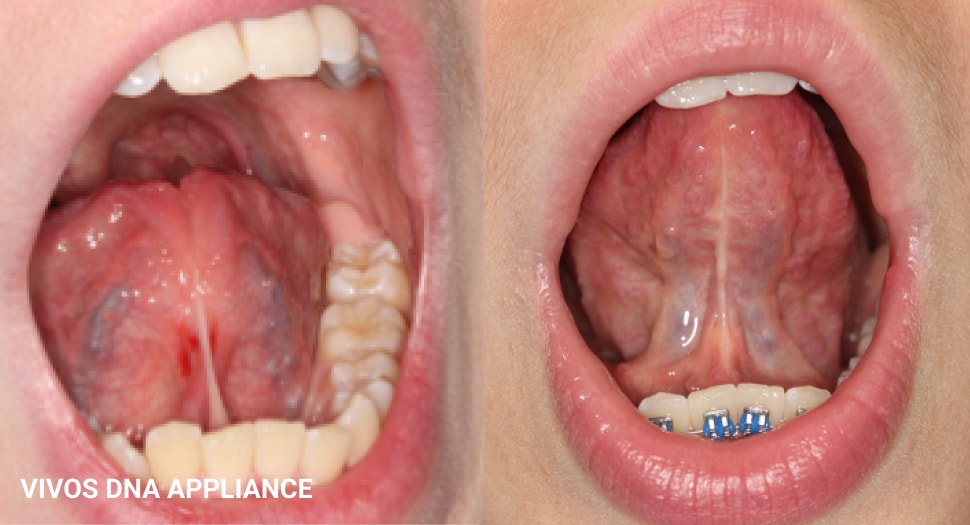Introduction
FORM AND FUNCTION
In the 1990’s an experimental research facility called “Biosphere 2” was constructed in Arizona. The purpose of the experiment was to see if humans could survive in a self-contained space. The plants had pure air, water and the necessary minerals to grow rapidly. They grew faster than normal, actually. However, a peculiar thing occurred when the plants approached maturation—they toppled over. The scientists realized that one important element of the “real world” was missing—wind. Wind helps the plants create strong root systems as they develop and also helps create stress wood. Without wind the tree could grow, but did not develop the wide network of roots or wood in the trunk to support the weight of the tree.
And so it goes with all living things, including humans and development of the head, airway and teeth. The trees that developed without wind had the same genetic code as those trees in nature, but they didn’t grow the same way without wind to encourage the outward growth of roots or increased strength in the trunk and branches. In the past, humans ate hard, raw food that was relatively low in nutrients compared to the soft, cooked and nutrient fortified foods of today. The result was improved muscle tone of the chewing muscles and tongue, which in turn aided in the formation of bone surrounding the teeth and face. Anthropologic study of ancient human skulls showed a much wider and more developed dental arch, along with wider nasal passages (which we assume would be easier to breathe through). In the 1930’s, dentist Weston A. Price visited indigenous cultures and noted physiologic changes to the dentition and face when people adopted a western diet vs. their traditional diet. These changes included increases in decay and crowding of teeth.
Our view at Boise Integrative Dentistry is that both lack of proper chewing and improper placement and/or function of the tongue are major contributing factors to many common orthodontic problems such as crowding, open bites, and spacing of the teeth. Ideally, when at rest, the tongue should sit fully on the roof of the mouth, pushing up on the bones of the maxilla that form the hard palate. During swallowing, the tongue should also push up towards the roof of the mouth and move food down the throat. When the tongue is low during rest or swallow, or a person breathes through their mouth, the soft palate must elongate to prevent food from going into the nasal cavity. In fact, a long soft palate is a risk factor for sleep-related breathing disorders such as sleep apnea. Improper tongue posture can therefore cause crowding of the dental arches, open bite, or incorrect growth patterns in the lower jaw. Different types of tongue dysfunction or placement lead to different presentations of malocclusion or changes in facial growth.
Mouth breathing and tongue posture problems can cause changes in the overall body posture, especially moving the head forward and placing stress on the neck. In addition, the dental arches can become crowded or uneven while displacement of the mandibular condyle from ideal position can cause pain in the temporomandibular joints and/or surrounding muscles. While dental crowding is often the chief concern of parents, it is a visible sign that the structures of the face and airway are not developing ideally.
Myofunctional orthodontics involves the use of permanent, removable and/or semi-removeable appliances and/or exercises that affect not only the teeth but the posture of the jaw and encourage ideal growth of the face. This is done through light expansion of the arches and improvement of tongue posture. The actual treatment plan necessary will be determined by the degree of crowding or tongue dysfunction and the age of the child. Since studies show 90% of the growth of the head is completed by age 12, ideally problems are identified as early as possible and the underlying issues causing these problems are corrected. Without fail, our treatment plan includes improving chewing and tongue function. Our appliances can be thought of as ways to facilitate the return to ideal function, and thus form, of the teeth, jaws and airway.
GOALS OF TREATMENT
The goal of myofunctional orthodontics is to improve development of the face and airway through creating an ideal resting and swallowing posture of the tongue. In addition, our appliances and treatment modalities work to expand the dental arches and improve the position of the lower jaw, thus improving the airway. Consequently, the majority of patients end up with straight teeth when the tongue function is corrected. Those who need braces in the future usually find the corrections necessary are minor and take less time than those who did not have myofunctional orthodontics. In addition, ideal tongue and swallow posture reduces the risk for relapse and crowding in the future.
Treatment Times
Active treatment time can be between 12-24 months, with appliances often being worn longer during retention when necessary. Recommended treatments will depend on the degree of severity of crowding and symptoms, as well as the patient and family motivation.
THE TREATMENT PROCESS
Our doctors feel strongly that the first step in creating a successful treatment plan is obtaining an accurate diagnosis of the problem. We start with a comprehensive medical history discussing the history of the problem and symptoms to obtain a holistic picture of the patient. Due to the effect of sleep quality on many of the symptoms we monitor, we also want a sleep study. This can be performed using a take home sleep study, a Vivoscore ring, or a lab sleep study, depending on the age of the patient and symptoms. At the comprehensive examination appointment, we will review the medical and dental history, take intraoral photographs and usually take a cone beam CT scan or panoramic radiograph (depending on age). After all the data has been given a summary will be presented.
It is very important to realize that most of our treatment options are patient compliance-based and may involve referrals to other practitioner concurrently with our recommended dental treatments. Some examples are referrals to myofunctional therapists, cranial osteopaths, functional medicine practitioner, naturopaths, physical therapists, craniosacral therapists, or Ear, Nose and Throat physicians. The goal is to remove barriers that prevent natural growth and development. We also utilize removable appliances in many cases. If the appliances are not worn correctly for the prescribed amount of time the treatment results will be compromised.
If you do not think your child can or will be compliant with these recommendations, our office may not be the right place to seek treatment. We are always happy to recommend orthodontic specialists who utilize other (fixed appliance) techniques for these cases. We want the best result for each patient based on their unique situation.
TREATMENT OPTIONS
Our doctors will determine which of the treatment options below, if any, are the best for each child. As each case is different, the plan will be determined based on patient presentation and need.
TONGUE HABIT CORRECTION
Habit correction only with a habit trainer system such as Myobrace, Vivos Guides, or Healthy Start. This usually involves the use of 1-2 appliances and 6-9 months of treatment. This treatment is best utilized using a myofunctional therapist to aid in exercises to correct tongue posture, but many kids will achieve improved tongue posture with the appliance alone. Treatment involves getting records, selecting the correct appliances, and monitoring usage for 3-6 months. Treatment modifications and referrals may be necessary to achieve success with the habit correction.
Below is a case successfully treated by Dr. Dan Bruce only using the Myobrace system. This case involved an anterior tongue thrust. The case took 1 year to treat, and we were able to use the habit corrector only due to the lack of considerable crowding, excess overbite, excess underbite or crossbites.

HEALTHY START

Treatment with Healthy Start can commence between 3 and 12 years of age. The best time to start is before age 8 in order to capture growth, however benefits can be seen at all ages. Habit correction is the first phase of Healthy Start. Once the patient can wear the habit corrector 2-4 hours during the day and all night for at least 30 days we can move into the Healthy Start Occluso-guide phase. These appliances encourage proper tongue and swallowing posture while moving the teeth into proper position. Healthy Start claims have shown 90% of kids who wear these appliances for the recommended period of time do not need braces after treatment. In cases needing significant expansion, we may recommend an orthodontic expansion device prior to or while in treatment with the removable appliances. Visits are also made on a monthly basis during active treatment and then longer intervals once initial correction has been made.
Healthy Start has a strong emphasis on sleep-related breathing disorders and the signs and symptoms associated with these problems. We monitor these signs and symptoms as treatment progresses to make sure they are improving. When a child is not progressing, we may need to refer them to the Ear, Nose and Throat (ENT) physician, functional medicine physician, or allergist.
The case below was successfully treated by Dr. Dan Bruce with the Healthy Start system. The patient had a lateral tongue thrust, along with narrowing in the upper and lower arches causing crowding and flaring. The treatment plan consisted of wearing the appliance 1-2 hours a day with active jaw exercises, as well as all night.

ADVANCED LIGHT FORCE (ALF)
Advanced Light Force (ALF) treatment has the advantage of providing slow, physiologic development of the dental arches, face, and airway. Developed by Dr. Derrick Nordstrom, the ALF was designed while considering the osteopathic principles of light force to generate cranially friendly and significant changes in growth. ALF treatment can start at any age, but younger patients see the most rapid changes. ALF treatment works well in conjunction with myofunctional therapy and cranial osteopathy after a very comprehensive medical, dental and health history. Except in very mild cases, ALF or some other form of expansion is almost always the recommended treatment in our office because it provides the physiologic expansion and development, plus helps shape the growth of the jaws, face and head in 3 dimensions.
Dr. Dan Bruce is the resident expert in Advanced Light Force (ALF) treatment. He has completed a 3 year mini-residency with the ALF Educational Institute. For more information on ALF please watch our video testimonials above.


VIVOS
Vivos appliances work using what Dr. Dave Singh, the inventor of these appliances, calls epigenetic orthodontics. The appliances provide periodic, light forces on the bones of the jaw to create bone growth. These forces can be applied to kids and adults. All doctors in our practice are trained to use Vivos appliances. They have the advantage of being removable, so cleaning the teeth is much easier. However, like many of our treatments, they are compliance-dependent and require wear during the day and night when in the active phase of treatment.

HEALTHY START ORTHOTAINE APPLIANCE
PHASE 2 TREATMENTS
After Myobrace, Healthy Start, Vivos or ALF has been utilized to gain proper tongue and lip posture, closed mouth breathing and arch development, a variety of options are available for phase 2 finishing. Finishing means placing the teeth in an ideal esthetic and functional position. Often the teeth are close to where they need to be prior to finishing and in many cases, when the tongue and lips function correctly, no finishing is necessary. However, we cannot and do not guarantee perfectly straight teeth after phase 1.
Phase 2 can either consist of metal braces or clear aligners. With either treatment we take great care to not undo what was gained during Phase 1 treatment.
RETENTION AND FOLLOW-UP
After the active phase of treatment, we will recommend a follow-up interval. The purpose of follow-up is to determine the stability of treatment and make adjustments or referrals as needed. Active treatment time will be estimated before treatment is started. However, as each patient is very different, the final active treatment time can be affected by patient compliance and many other factors. Often, follow-up can be completed during hygiene examinations or 3-6 month intervals. In general, if an optimum swallow, tongue and breathing posture can be established then less relapse is seen. In some cases, patients will need a retainer, in others they will not.
REFERRALS AND ADDITIONAL TREATMENT PROCEDURES
One big advantage to our office is the network of referrals we can offer to deal with muscle and joint pain, food intolerances and functional medicine, and sleep and breathing problems. Your child may be recommended to see one of our specialists in a different area to achieve maximum medical benefit.
Many children can achieve correction of myofunctional habits through use of appliances and our office myofunctional therapy. Some very difficult cases may be referred to an outside myofunctional therapist. This is outside the fee structure at our office and fees will be determined by the therapist you choose to work with.
We are very big believers in the benefits of cranial osteopathy and craniosacral treatments by qualified practitioners. We believe the body has an amazing capacity to heal when impediments are removed and optimal function is encouraged.
In addition, there are children who also have restrictive frenum attachments of the lip and/or tongue. Revision of these restrictive frenum attachments may need to be done at our office.
Below is an example of a restrictive lingual frenum of the tongue that we believe contributed to malocclusion. Our plan involved myofunctional therapy prior to surgery and post-operative myofunctional therapy to ensure the frenum did not reattach. We believe that achieving proper tongue therapy is part of orthodontic stability (preventing relapse) and improvement in overall health.

FIRST STEPS
Treatment can begin as early as 3 or 4 years old, depending on patient behavior and compliance. We start with a one-hour appointment for a comprehensive orthodontic examination, sleep screening assessment, photos and impressions. In addition, we will need a dental radiograph of the jaws and teeth, either a panoramic or 3-dimensional cone beam image. The examination is usually not covered by insurance and the imaging may or may not be covered. We will provide you with an estimate before starting treatment. Within a week or two you will receive a review of the findings, as well as a recommended treatment plan.
WHO IS A GOOD CANDIDATE FOR MYOFUNCTIONAL ORTHODONTICS?
Most children in modern society could benefit from myofunctional orthodontics. If you want to improve your child’s growth and development of the head, face and airway it is a great option. Myofunctional orthodontics also aims to treat the root cause of crowded teeth, which means there is less likelihood for relapse (the return of crowding after treatment). This almost always mean changing the habits and behaviors that lead to crowded teeth. These include mouth breathing, tongue thrust, tongue tie, and soft diet. If you are willing to address these issues as we utilize our appliances and techniques, your child is a good candidate for our services.
WHO IS NOT A GOOD CANDIDATE FOR MYOFUNCTIONAL ORTHODONTICS?
Myofunctional orthodontics requires compliance from the patient in wearing their appliances, eating the proper food, and doing exercises to compliment treatment. In addition, we may refer your child to a functional medicine physician, ear nose and throat (ENT) physician, cranial osteopath, physical therapist or another health care practitioner if our initial therapies do not achieve our goals of nasal breathing and proper tongue posture. If you do not think your child can do these things on a consistent and regular basis, or you are unwilling to explore the multifactorial nature of fixing functional problems, myofunctional orthodontics may not be the right choice. There are several excellent orthodontists who can provide treatment with wires and brackets that are not able to be removed from the mouth. If there are any questions about which treatment is right for you, we encourage you to get an evaluation. Finding the right orthodontic treatment is a big decision and everyone (parents, child and the dentist) should be on board with the goals and necessary changes to lifestyle that are required for a successful outcome.
FINAL THOUGHTS
The dentists and staff at our office fully believe in the value and improvement in health that can be achieved through myofunctional orthodontics. In fact, Dr. Bruce has treated himself and all his family this way. We are constantly learning and evolving in order to make the treatments more predictable and beneficial for patients through yearly continuing education in these areas. Orthodontics is a big decision, and we believe in thorough evaluation of medical history, structure and function of each individual patient in order to provide personalized treatment recommendations. We are very grateful to be part of this journey to wellness for you and/or your child.
